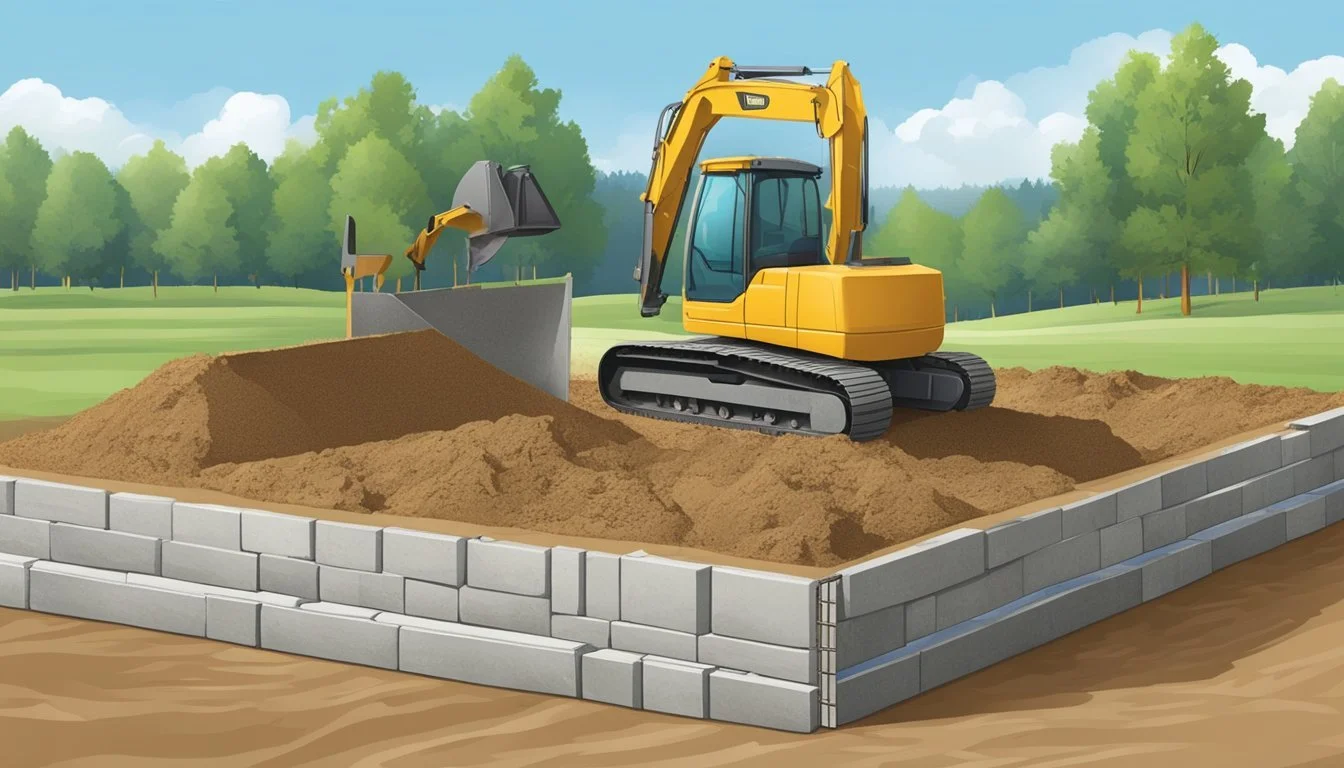The Importance of Leveling Structures
Ensuring Alignment in Your Homestead Layout
Leveling is a fundamental aspect of constructing any structure, including additions to a homestead. It refers to the process of making a surface horizontal and evenly balanced. The precision achieved through leveling is crucial, as it directly impacts the stability and durability of a structure. An accurately leveled foundation is a cornerstone for the long-term viability of buildings and other constructs on a property. A level base ensures weight is distributed evenly, preventing structural stress and possible distortions over time.
Accuracy in leveling not only supports structural integrity but also contributes to the aesthetic appeal of a homestead. Sinks, countertops, and other elements within a home will align correctly only when the foundational leveling is precise. In outdoor spaces, outbuildings like sheds must rest on level ground to avoid water pooling and potential damage to the building and contents within.
The quality of leveling work is seen in the longevity and functionality of a structure. Impeccable alignments, facilitated by precise leveling can lead to fewer repairs and an enduring homestead. Ensuring level and plumb structures can be achieved through traditional tools, such as spirit levels, or modern equipment like laser levels, each serving the purpose of establishing a true horizontal plane on which to build a firm and secure homestead.
Fundamentals of Leveling
Leveling is a crucial step in construction that ensures structures stand on a flat, stable foundation. This process, when executed with precision, avoids various future problems such as structural damage or uneven settling.
Understanding Leveling
Leveling is the process of determining the height of one point relative to another. It is a critical step in ensuring that a construction site is perfectly flat before the commencement of a building project. Engineers or surveyors typically perform leveling to establish a reference point known as a benchmark. This is a starting point from which all other elevations are determined.
Importance of Precision
In construction, precision in leveling is synonymous with the stability and longevity of a structure. Buildings, roads, and even landscapes rely on accurate leveling to prevent issues. An uneven foundation can lead to compromised stability and costly repairs down the line. Therefore, construction teams place significant emphasis on achieving a level surface before proceeding with any project.
Tools of the Trade
The tools used in leveling must be precise and reliable. Here is a breakdown of common leveling tools:
Spirit Level: A traditional tool that uses a bubble in a vial of liquid to find the horizontal plane.
Laser Level: A more advanced tool that projects a straight laser beam and can be used over longer distances.
Digital Level: Offers electronic measurement readouts and may also use laser technology for enhanced precision.
Construction professionals choose their tools based on the complexity and requirements of the project, ensuring that every level is accurate down to the millimeter. These tools are instrumental in creating level surfaces and lines, which form the fundamental basis of any successfully engineered structure.
Leveling in Construction
In construction, the process of leveling is pivotal in ensuring stability and structural integrity. By precise measurements and techniques, it mitigates terrain challenges and enhances the longevity and safety of a building.
Foundation and Stability
A construction project's longevity heavily relies on how well the foundation is set. Leveling ensures that the foundations are horizontal and even, which is critical for distributing loads and maintaining the overall stability of the structure. Accurate leveling at this stage helps to prevent future settlement issues and structural damage.
Tackling Terrain Challenges
In the face of uneven or sloped terrain, leveling is indispensable for creating a flat base on which to build. It involves techniques such as grading and excavation to adjust the soil and shape the land to suit the needs of the construction project. This step is crucial for ensuring that the foundations are laid correctly and the resulting structures are perfectly aligned with the planned design and layout.
Ensuring Safety and Integrity
Safety in construction is non-negotiable, and leveling plays a significant role in it. Properly leveled surfaces help prevent accidents during construction and after the structure is built. Moreover, a well-leveled building is indispensable for maintaining structural integrity, thereby reducing the risk of collapse or failure over time due to uneven stress or load distribution. It is a fundamental aspect that supports the structural health and facilitates secure habitation.
Leveling Techniques and Equipment
Proper leveling of structures is critical to ensure stability and longevity. This section explores the equipment and methodologies vital for achieving a perfect alignment and highlights how technological advancements have influenced the industry.
Traditional vs. Modern Equipment
Traditional equipment such as spirit levels and plumb bobs have been the foundation of construction leveling for centuries. Spirit levels provide a visual cue for when a surface has reached a state of equilibrium, useful for small-scale projects. However, for larger or more precision-critical tasks, modern equipment offers enhanced accuracy.
Laser levels have revolutionized the industry, projecting precise, visible lines along surfaces or from point to point.
Optical levels, sometimes known as auto levels, are used for larger site mappings which require both horizontal and vertical angle measurements for a comprehensive view of the area's topography and slopes.
Advancements in Leveling Technology
Incorporation of digital and laser technology has not only permitted a greater accuracy in terms of achieving a level surface but has also expedited the process significantly. Specialized tools integrated with digital readouts can now provide real-time feedback and store measurements for further analysis. Furthermore:
3D mapping technology has given engineers the ability to build detailed topographical maps with exact height data.
Automated motorized levels that can self-level using internal pendulum systems and electronic sensors ensure precision without constant manual adjustment.
Practical Leveling Methods
Employing the correct leveling technique is paramount to successful application. Contractors use various approaches depending on the complexity and requirements of the project:
For simple home projects, manual methods using standard levels are often sufficient.
On construction sites, techniques that use robust, calibrated laser levels ensure that large foundations are set correctly.
Slopes for drainage require precise measurements typically obtained with digital technology to avoid water pooling or improper runoff.
By selecting the appropriate equipment and utilizing the most fitting method, one can guarantee that the structure built is correctly aligned, providing safety and structural integrity to any homestead.
Challenges and Solutions in Leveling
When building a homestead, it's essential to address specific issues such as uneven terrain and unpredictable environmental elements to ensure a stable and aligned structure.
Dealing with Height Differences
In construction, height differences can lead to structural damage if not addressed properly. The challenge is to create a level base across varying elevations, which is crucial for the integrity of the building.
Solutions:
Earthworks: Utilizing excavation and filling to modify the terrain.
Precise Measurement Instruments: Implementing laser levels and digital tools that provide real-time feedback to achieve an even surface.
Addressing Environmental Factors
Environmental factors can interfere with the leveling process, resulting in collimation errors or inaccuracies due to curvature and refraction. These factors can distort the line of sight in surveying, which is fundamental in establishing a level plane.
Solutions:
Standard Corrections: Applying mathematical corrections for curvature and refraction.
Environmental Monitoring: Measuring environmental conditions and using that data to adjust equipment calibrations.
Accuracy and Errors in Leveling
Accurate leveling is essential to ensure structures are built on even surfaces, crucial for stability and compliance with building codes. This section explores typical leveling errors, strategies to enhance leveling precision, and the industry's best practices.
Common Leveling Errors
Leveling, while critical, is susceptible to several errors which can compromise the project's precision. Instrumental errors occur when there is a malfunction or misalignment of the leveling instruments. Collimation errors happen when the line of sight is not truly horizontal. Additionally, natural factors like curvature of the earth and atmospheric refraction can cause inaccuracies if not properly accounted for.
Instrumental Error: Misalignment or imperfections in equipment
Collimation Error: Misjudgment in establishing a horizontal line of sight
Natural Factors:
Curvature: Earth’s surface curvature affecting line of sight
Refraction: Light bending due to atmosphere altering the perceived level
Improving Leveling Accuracy
To improve the accuracy of leveling, it is critical to perform thorough site preparation and ensure the equipment is calibrated correctly. Frequent checks against known benchmarks can prevent the accumulation of errors. Additionally, employing precise leveling techniques, where a more refined surveying process is used, helps achieve high levels of precision.
Calibration: Regular equipment checks and calibration
Benchmarks: Use of reliable benchmarks for reference
Precise Techniques: Adoption of precise leveling methods
Standards and Best Practices
Following established standards and best practices is key to minimizing delays and rework due to leveling errors. The industry emphasizes rigorous training for surveyors and consistent application of methodologies to achieve true and accurate measurements.
Training: Ensuring surveyors are well-trained in handling instruments
Methodology: Applying consistent methods to every surveying phase
Documentation: Keeping detailed records for accountability and verification
By adhering to these standards, surveyors can ensure an aligned homestead, where accuracy is not left to chance and the precision of the construction aligns with the intended design and structural requirements.
Impact of Leveling on Structures
The process of leveling profoundly influences the longevity of a structure and its operational costs over time. Ensuring that every aspect of a building is level is integral to its overall performance and efficiency.
Durability and Performance
Leveling is essential for maintaining a structure's durability. It ensures that weight is distributed evenly, reducing the stress on any single point, which can cause premature wear and tear. For occupants, a level structure means minimal risks of tripping hazards, contributing to a safer environment. Moreover, accurate leveling during construction prevents misalignments that might necessitate costly repairs.
Even Weight Distribution: A level base evenly distributes weight, which reduces strain on the structure.
Reduced Wear and Tear: Structures that are properly leveled experience less stress on joints and materials.
Safety for Occupants: Level floors lower the risk of trips and falls.
Energy Efficiency and Costs
A level structure aids in energy efficiency, particularly in the heating and cooling systems. When a building is not level, doors and windows may not fit properly, leading to air leaks and energy loss. Heating and cooling costs are directly impacted by how well a space is sealed and insulated, which is directly affected by how level the structure is.
Sealing and Insulation: Properly aligned and level structures facilitate better sealing against external weather conditions, improving insulation.
Heating and Cooling Costs: An uneven structure can lead to increased energy consumption, as HVAC systems work harder to maintain consistent temperatures across poorly insulated areas.
Leveling and Structural Character
In the context of a homestead's alignment, leveling is a critical process that determines the overall structural character, directly impacting both aesthetic appeal and functional integrity.
Aesthetic and Functional Aspects
Leveling has a profound influence on the aesthetic harmony and functional aspects of a structure. Architectural lines and design elements demand precision—a level surface is essential to achieving the intended visual impact and ensuring structural stability. When floors and walls are perfectly level, there is a seamless transition between spaces, contributing to a coherent visual flow. Functionally, a level foundation allows for even weight distribution, averting stresses that could cause cracking and settling. For instance, ensuring that piers are vertical and plumb plays a critical role in maintaining the structure's upright integrity over time.
Structural Alignment
Walls: Must be perpendicular to leveled floors.
Doors/Windows: Leveling ensures they open/close properly.
Furniture: Sits flush and stable on level surfaces.
Historical and Archaeological Perspective
From an archaeological standpoint, the levelness of ancient structures provides insights into the technical capabilities and construction practices of past societies. Archaeologists consider the precision of leveling as a testament to a civilization's attention to detail and engineering acumen. Structures that have withstood the test of time, maintaining a level and plumb orientation, are often seen as markers of advanced technical skill. For example, in examining ruins, the structural character—as evidenced by remaining level strata and still-vertical walls—suggests the builders' proficiency and the structure's initial structurally sound construction.
Archaeological Observations
Consistency: Leveling accuracy in historical sites indicates construction expertise.
Survivability: Level foundations often correlate with structures' longevity.
Surveying and Mapping Techniques
Accurate surveying and mapping are crucial foundations for maintaining the precise elevations and alignment necessary in building a perfectly leveled homestead. They ensure that structures are constructed on a horizontal surface and remain plumb.
Surveying for Leveling Accuracy
Surveying constitutes the measurement and recording of the environment to determine positions of points and angles between them on the Earth's surface. Plane surveying is commonly utilized when working with small areas where the Earth’s curvature is negligible, providing a practical horizontal plane on which to reference elevations. Leveling is a specific type of surveying focused on determining the height of points, or differences in height, relative to a datum. It typically involves the use of instruments such as leveling rods and surveyor's levels.
One establishes benchmarks, which are fixed points with known elevations, as references throughout a survey. Accurate leveling requires systematic processes:
Initial leveling: to set up benchmarks across the site
Check leveling: to verify the differential leveling by taking a reverse route
Profile leveling: to determine the elevations at specific intervals along a line
These procedures ensure the success of establishing a leveled ground, critical before any construction begins.
Mapping and Elevation
Mapping complements surveying by visualizing the data collected, particularly elevations and contours to signify the terrain's slope. Having a visual representation enhances the understanding of land features, which is central to the planning and design of homestead layouts that require strict leveling for structural integrity. Precision in mapping is paramount to reflect true topography.
A typical approach to mapping:
Establish a grid of the surveyed area
Represent known benchmarks and surveyed points with symbols
Illustrate contour lines to demark elevation changes
Integrate leveling details with a topographic map
Digital tools, like Geographic Information Systems (GIS), offer advanced three-dimensional models that layer multiple points of data, providing an even more comprehensive mapping solution. These models aid in predicting how structures will align with the existing landscape and guide adjustments required for a leveled homestead.
Extensions of Leveling in Different Domains
Leveling is crucial for ensuring the structural integrity and longevity of various constructions. While it is often associated with the building of homes and commercial structures, leveling extends its utility to roads and soil preparation, where precise elevations are mandatory for safety and efficacy.
Leveling for Road Construction
In road construction, leveling is a fundamental step for defining the road grade and ensuring a smooth driving surface. Benchmarks are established to provide reference elevations, which are crucial in maintaining the road at the designed elevation. This precision in elevation helps to control water runoff and enhance the longevity of the road. However, if not properly executed, disadvantages can arise, such as improper drainage leading to road damage.
Advantages of leveling in road construction:
Ensures proper drainage and water management
Provides a smooth and safe driving surface
Helps in aligning roads with the surrounding terrain
Disadvantages of leveling in road construction:
Inaccuracies can lead to water pooling and premature road deterioration
Time-consuming process requiring skilled labor and precision instruments
Grading and Soil Compaction
Grading entails the leveling and slope adjustment of land, setting a suitable foundation for construction activities. It ensures a level building site that can support structures without the risk of shifting or sinking. Soil compaction, closely associated with grading, is a process where soil particles are densely packed together, increasing soil density and stability while reducing air pockets.
Grading:
Ensures a solid, level foundation for secure construction
Aids in proper drainage around the building, preventing water ingress and foundation damage
Soil Compaction:
Increases load-bearing capacity of the soil
Reduces the risk of soil settlement and structural integrity loss over time
Despite its benefits, grading and compaction can have drawbacks, such as disrupting the natural terrain and potential over-compaction leading to poor soil drainage. It is vital to approach these processes with expertise to maximize advantages and minimize disadvantages.
Conclusion
In the realm of homesteading, the integrity of structure alignment is paramount. Level foundations are fundamental to the sustainability and safety of homestead buildings. They prioritize vertical alignment and demonstrate a steadfast commitment to technical accuracy in construction. When a foundation is properly leveled, it bolsters the overall stability and longevity of a structure.
Accurate leveling ensures that each element of a homestead, from the main house to auxiliary outbuildings, stands resilient against the forces of nature. This meticulous approach to alignment aids in the prevention of potential issues such as uneven settling and moisture infiltration. The long-term benefits of such diligence are multi-fold, encompassing everything from structural soundness to ease of future expansion or modification.
It is clear that homesteaders must regard leveling not as a mere step in the construction process, but as an ongoing commitment to excellence in their way of life. Through appropriate leveling practices, they not only preserve the form and function of their buildings but also exemplify a meticulous and responsible approach to rural construction and lifestyle.
To encapsulate, in the pursuit of a well-aligned homestead, success lies in an unwavering attention to detail and an unyielding adherence to standards of vertical alignment. The practices detailed herein are not simply tasks to be checked off but are instead the foundations upon which resilient and enduring homesteads are built.







